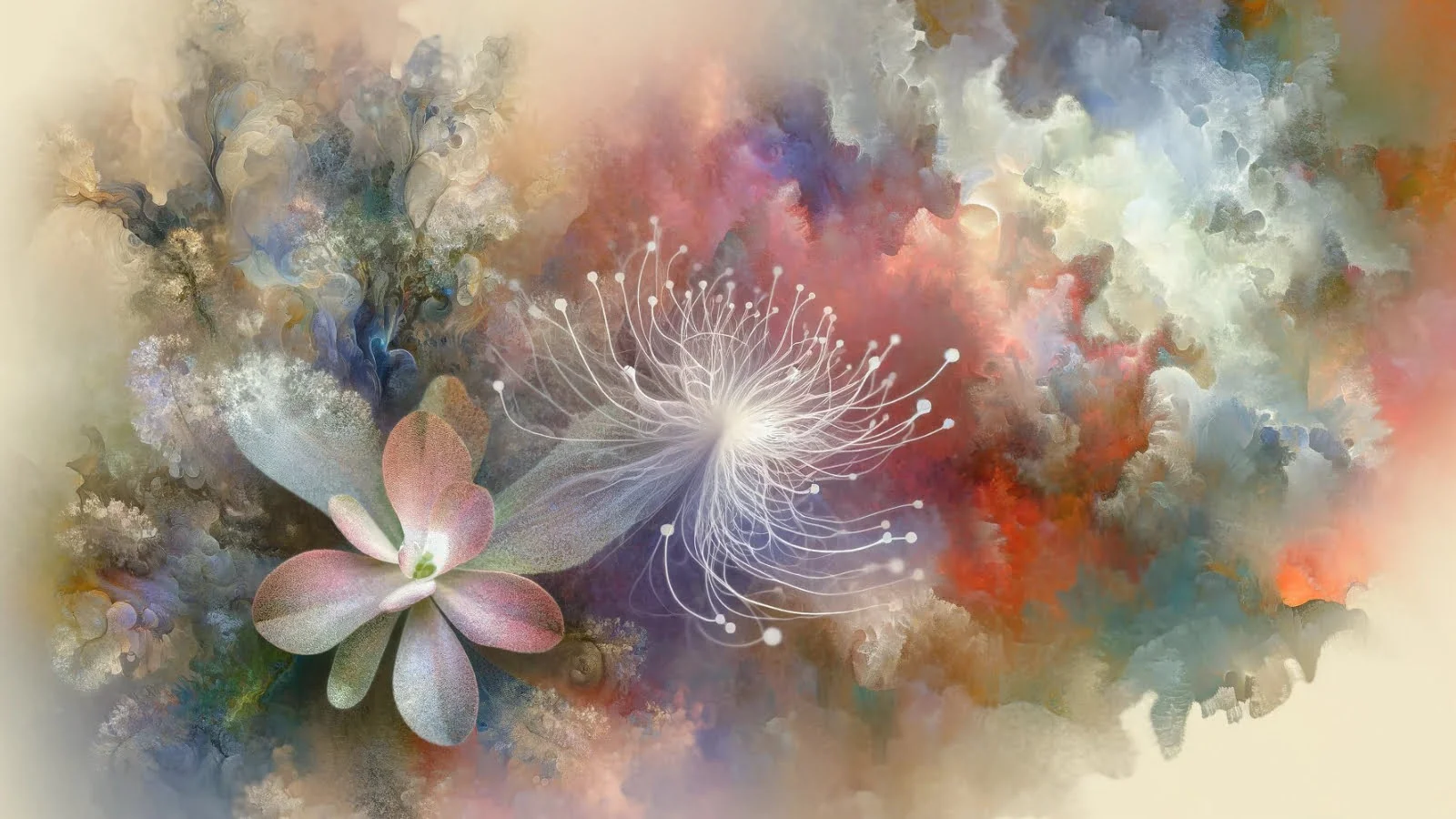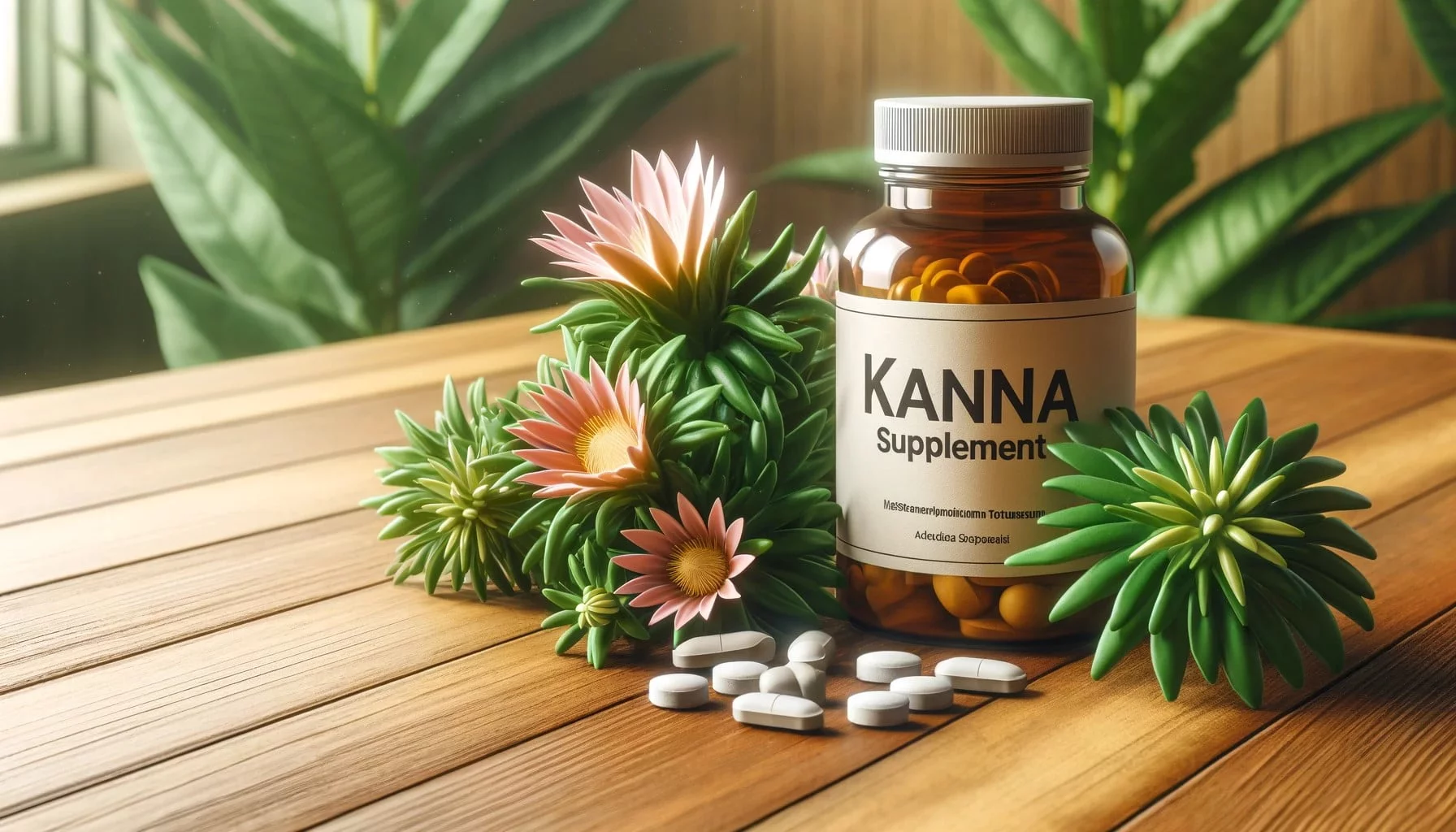
Kanna, a psychoactive plant native to South Africa, is a natural way to improve your mood, focus, and memory.
This unique succulent plant has been used for centuries for its medicinal properties. Now, professionals, athletes, and students are using it for its stress-reducing and antidepressant effects and memory-enhancing properties.
Its active compounds, primarily mesembrine alkaloids, modulate serotonin and other neurotransmitter systems.
While generally safe, proper dosing and awareness of potential interactions are crucial.
Kanna’s unique profile sets it apart from other nootropics, offering a balanced approach to cognitive enhancement and emotional well-being.
Table of Contents
What is Kanna?
Kanna (Sceletium tortuosum), also known as kougoed or channa, is a psychoactive succulent plant native to the semi-arid Karoo region of South Africa. It grows naturally in the wild and is also cultivated for its medicinal properties.
It has been used traditionally by the Khoi San people for its sedative, anxiolytic, and euphoric effects.
Kanna contains mesembrine alkaloids, which act as serotonin (happiness inducer) reuptake inhibitors (SRI), modulating serotonin levels in the brain.
Emerging research suggests Kanna has nootropic benefits for improving mood, reducing anxiety, and enhancing cognitive function.
Besides its nootropic benefits, Kanna also offers physiological benefits like pain relief, treatment of cough and fever, and appetite control.
What Active Compounds are Present in Kanna?
The main active compounds in Kanna, such as mesembrine, mesembrenone, and mesembrenol, primarily exert their effects by modulating serotonin activity in the brain.
Here’s how these compounds play an active role in the functions of the body:
- Serotonin Regulation: Mesembrine increases levels of serotonin in the synaptic region, enhances serotonin signaling
- GABAergic Activity: Reduces neuronal excitability by slowing down neurotransmission
- Endocannabinoid System Modulation: Activates cannabinoid receptors
- cAMP (cyclic adenosine monophosphate) Activity: Mesembrenone inhibits phosphodiesterase 4 (PDE4), raising synaptic plasticity through rising cAMP levels
- Other Neurotransmitter Systems: Regulates dopamine and melatonin levels
What Are the Nootropic Effects of Kanna?
Kanna has several nootropic benefits:
- Reducing anxiety and stress
- Enhancing mood and well-being
- Improving memory and learning skills
- Enhancing mental clarity and focus
- Providing hallucinogenic therapeutic benefits

Could Kanna be Used to Treat Anxiety and Stress Disorders?
Kanna is well-known for its sedative and anti-anxiety effects. By acting as a serotonin reuptake inhibitor, Kanna significantly reduces anxiety, stress, and nervous tension.
Furthermore, Kanna’s effect on GABAergic activity leads to reduced neuronal excitability and a calming effect on the central nervous system. This reinforces Kanna’s ability to alleviate anxiety symptoms and mitigate stress responses.
In one study, a single 25mg dose of Zembrin, a standardized Kanna extract, reduced anxiety during an interactive public speaking test. Participants also had lower amygdala reactivity to fearful stimuli.(1)
Another randomized controlled trial found that participants who consumed Kanna extract experienced significant reductions in anxiety levels.(2)
Some anxiety and stress conditions manageable by Kanna include:
- Social anxiety disorder
- Generalized anxiety disorder
- Panic disorder
- Stress management
- Sleep difficulties
Does Kanna Have Potential as an Antidepressant or Mood Stabilizer?
Yes, Kanna has shown potential antidepressant and mood-altering properties.
Kanna’s primary alkaloid, mesembrine, is directly involved with alleviating depressive states and providing emotional stability through maintaining serotonin levels in the brain.(3)
In a study investigating the relationship between depressive states and Kanna extracts, significant antidepressant-like effects were observed in the subjects.(4)
Kanna also influences dopamine levels, which helps stabilize mood swings and enhance emotional resilience.
Moreover, Kanna’s ability to elevate cAMP levels also contributes to its antidepressant effects.
Scientific research backs up these claims. A study demonstrates that Kanna extract had significant antidepressant-like effects comparable to fluoxetine (Prozac).(5)
Can Kanna Improve Memory and Learning?
Yes, Kanna can improve memory and learning by promoting synaptic growth.
Kanna optimizes brain conditions by enhancing synaptic plasticity by boosting cAMP levels. This optimization has a favorable effect on improving memory retention and learning focus.
A study shows the rise in anti-inflammatory activity in the brain, pushed by enhanced cAMP levels, leads to better learning habits and memory retention capacity.(6)
Kanna’s ability to control reuptake levels of serotonin raises the state of happiness and well-being, promoting a better learning mindset and memorizing conditions.
A study checking the acute effects of Kanna shows this tendency to keep serotonin at a certain level in the brain, which raises the brain’s capacity to grow memory and learning muscles.(7)
How Does Kanna Support Mental Clarity and Focus?
A good primer to heightened focus and conscious thinking is the ability to regulate mood swings and emotional outbursts.
Kanna slows down such anxiety symptoms while improving mood through its calming effects. This therapeutic pathway has a direct effect on improving attention and mental acuity.(8)
Moreover, the serotonin level increase caused by Kanna also facilitates clear thinking.
Kanna’s ability to recondition gamma-aminobutyric acid (GABA) slows excessive neuronal firing, calming the mind and reducing distractions.(9)
Does Kanna Have Hallucinogenic Effects?
At common doses, Kanna does not typically cause strong hallucinations. However, some users report enhanced colors, patterns, and closed-eye visuals, especially at higher doses.
Kanna’s (mild) hallucinogenic effects are usable for therapeutic purposes that help treat mental health issues like depression, anxiety, PTSD, and substance abuse disorders.
A study reports that participants experience increased sensory perception and subtle changes in visual and auditory experiences at higher doses of Kanna, in PTSD patients.(10)
What Are the Recommended Dosages of Kanna?
The optimal dosage of Kanna depends on several factors, including the specific extract or preparation, individual tolerance, and desired effects.

Here are some general dosage guidelines based on available research and anecdotal reports:
| Form | Light Dose | Strong Dose |
| Standardized Extract (e.g., Zembrin) | 8-12 mg per day | Up to 50 mg per day |
| Powdered Kanna | 100-200 mg per day | 500 mg per day |
| Dried Kanna Herb | 100-200 mg | 400-600 mg |
| Kanna Tincture or Liquid Extract | 0.5-1 mL | 2-3 mL |
| Kanna Extract Powder | 50-100 mg | 200-300 mg |
Kanna extract powders are typically standardized to contain a certain percentage of mesembrine alkaloids. Effects last 2-4 hours.
Some general standards for optimal consumption of Kanna include:
- Start with a low dose and gauge your response. Some people may be more sensitive to Kanna’s effects than others.
- It’s also a good idea to take Kanna on an empty stomach for maximum absorption.
- Wait at least 2-3 hours before taking more Kanna. Re-dosing quickly can lead to nausea or dizziness.
- For regular use, take Kanna 3-4 times per week to avoid building tolerance.
- Cycle off periodically to maintain sensitivity.
What are the Risks and Safety Concerns of Using Kanna?
While Kanna has a long history of traditional use and appears to be well-tolerated, there are some potential risks and safety concerns to be aware of, especially with chronic high-dose use.
What are the Potential Side Effects and Adverse Reactions to Kanna?
The most common side effects reported with Kanna use include:
- Headache
- Nausea
- Dizziness
- Drowsiness
- Dry mouth
- Dilated pupils
- Diarrhea
- Insomnia (with daytime use)
Are There Any Known Contraindications or Drug Interactions with Kanna?
Yes, there are some potential contraindications and drug interactions to consider before using Kanna:
- MAOI (monoamine oxidase inhibitors): Lead to serotonin syndrome, wait 2 weeks before using MAOIs and Kanna
- SSRI (serotonin reuptake inhibitors): Agitation, tremor, and hyperthermia, people on antidepressants should avoid
- Sedatives: Benzodiazepines, sleeping pills, depressants, and muscle relaxers
- Pregnancy/nursing: Avoid due to lack of safety data
- Psychiatric conditions: Bipolar disorder
- Surgery: Discontinue 2 weeks before a scheduled surgery
Does Kanna Pose a Risk of Dependence or Addiction?
The risk of Kanna dependence or addiction is low compared to other psychoactive drugs. However, frequent high-dose use can lead to tolerance.
While not physically addictive like opioids or stimulants, abrupt discontinuation of chronic Kanna use may cause a withdrawal syndrome, causing:
- Irritability
- Low mood
- Sleep disturbances
- Cravings
- Headaches
What are the Signs of Kanna Abuse or Overdose?
A Kanna overdose is rare but potentially dangerous. Excessive dosing can lead to serotonin toxicity, with symptoms like:
- Agitation
- Tremors
- Muscle rigidity
- Hyperthermia
- Rapid heartbeat
- High blood pressure
- Seizures
- Coma
If serotonin syndrome is suspected, seek emergency medical attention immediately.
Overdose risk is higher when combining Kanna with other serotonergic drugs.
How Does Kanna Compare to Other Nootropics?
While it shares some similarities with other natural nootropics, Kanna has a distinct effect profile. Also, its benefits can be enhanced by carefully choosing the right complementary supplement.
Here’s a quick comparison of how Kanna matches up with some other popular nootropics:
| Supplement | Similarities | Differences |
| Ashwagandha | Anxiety reduction, stress relief | More gradual effects, less psychoactive |
| Rhodiola Rosea | Mood enhancement, fatigue reduction | Energizing rather than sedating |
| St. John’s Wort | Antidepressant effects, anxiety relief | Higher risk of drug interactions, less euphoric |
| Kava Kava | Strong anxiolytic effects, relaxation | More intoxicating, less cognitive benefit |
| 5-HTP | Serotonin enhancement, mood support | Narrower effect profile, more side effects |
| Phenibut | Rapid anxiety relief, mood boost | Stronger sedation, higher addiction potential |
| Bacopa Monnieri | Memory enhancement, stress reduction | Slower onset of effects, less psychoactive |
| Ginkgo Biloba | Cognitive enhancement, neuroprotection | More focused on circulation, milder anxiolytic |
| Lion’s Mane | NGF stimulation, cognitive support | Slower acting, less direct mood effects |
| CDP-Choline | Acetylcholine enhancement, memory support | No anxiolytic or mood effects |
While Kanna may not be the strongest in any one domain, its well-rounded benefits and safety profile make it an attractive option for many.
Can Kanna Be Combined with Other Nootropics for Enhanced Effects?
Yes, Kanna can be combined with other nootropics to create a synergistic effect.
Here are some nootropics that may combine well with Kanna:
- Ashwagandha: Greater relaxation, emotional resilience, and neuroprotective benefits
- Bacopa monnieri: Balances mental sharpness and anxiety reduction
- L-theanine: Promotes alertness
- Gotu kola: Cognitive-enhancing and neuroprotective properties
- Brendler, Thomas, et al. “Sceletium for managing anxiety, depression, and cognitive impairment: a traditional herbal medicine in modern-day regulatory systems.” Current Neuropharmacology 19.9 (2021): 1384.↩
- Chiu, S., et al. “Investigation of the anxiolytic effects of Sceletium tortuosum in healthy subjects: a randomized controlled trial.” Journal of Clinical Psychopharmacology, vol. 34, no. 2, 2014, pp. 185-191.↩
- Meltzer, Herbert Y. “Role of serotonin in depression.” Annals of the New York Academy of Sciences (1990).↩
- Schell, Rebecca. “Sceletium tortuosum and mesembrine: a potential alternative treatment for depression.” (2014).↩
- Harvey, Alan L., et al. “Pharmacological actions of the South African medicinal and functional food plant Sceletium tortuosum and its principal alkaloids.” Journal of Ethnopharmacology 137.3 (2011): 1124-1129.↩
- Lee, Daewoo. “Global and local missions of cAMP signaling in neural plasticity, learning, and memory.” Frontiers in pharmacology 6 (2015): 154210.↩
- Terburg, David, et al. “Acute effects of Sceletium tortuosum (Zembrin®), a dual 5-HT reuptake inhibitor and PDE4 inhibitor, on the fear response in healthy volunteers: A double-blind placebo-controlled trial.” Neuropsychopharmacology, vol. 38, no. 13, 2013, pp. 2708-2716.↩
- Smith, Angela M., et al. “Effects of Mindfulness-Based Stress Reduction on Mindfulness, Mental Well-being, and Perceived Stress: A Randomized Controlled Trial in Urban Schoolteachers.” Mindfulness, vol. 11, no. 5, 2020, pp. 1166-1178.↩
- Gericke, Nigel, and Barbara van der Watt. “Sceletium—a review update.” Journal of Ethnopharmacology, vol. 159, 2015, pp. 83-91.↩
- Lyndon, Stanley, and Philip R. Corlett. “Hallucinations in posttraumatic stress disorder: Insights from predictive coding.” Journal of Abnormal Psychology 129.6 (2020): 534.↩
